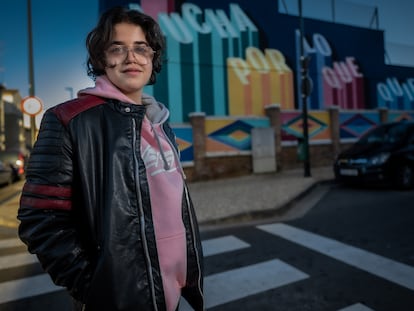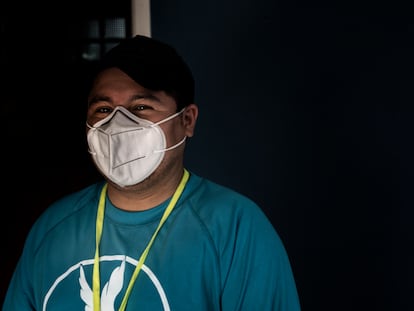Gilda Love, the 97-year-old drag queen who survived it all: ‘They cut up my dresses with razors, but I just danced in the shreds’
A new film portrays the daily life of the icon of Barcelona’s queer underground who survived the Franco years and still performs today

“The neighbors smile / from their back-alley windows [...] The sissies of the south / sing on the roof terraces!” This verse from Federico García Lorca’s Canción del Mariquita (or, Song of the Sissy) is the inspiration for the title of a new film by director Enric Ribes: Cantando en las Azoteas (Singing on the Roof Terraces). A hybrid of documentary and fiction, the film follows legendary Spanish drag queen Gilda Love, an icon of Barcelona canalla – the city’s wild and now nearly extinct underground scene – as she lives out her daily routine in El Raval, a neighborhood in Barcelona’s Ciutat Vella district.
Ribes’ feature-length film, which opened in theaters in July, captures Love’s intimate relationships with her neighbors through her involvement with a neighborhood mutual aid network, as she struggles to pay her bills with what little she earns from a small pension, and from the shows she still puts on despite being nearly a century old. “I’ve seen her have a 38-degree fever, but she still puts on her dress, goes out on stage, and becomes completely transformed. She turns solid and strong. Her feet might hurt, she might be having a bad day, but her passion for art prevails every time,” says Ribes, who has been friends with Gilda for over half a decade.
Born with the name Eduardo, before Spain proclaimed the Second Spanish Republic in 1931, 97-year-old Gilda Love has long been a symbol of Barcelona’s legendary queer underground scene. She moved to Cataluña’s capitol in 1967, in the waning years of the Franco dictatorship, and then never left. After completing compulsory military service, Love traveled and acted in some of the world of drag’s most famous venues and nightclubs, such as the Madame Arthur cabaret in Paris. She left behind her family, who taught her to live a life of performance at a young age – they were carnies, and traveled around when Love was still a small boy, singing and dancing in town after town. She also left behind her older brothers, supporters of Spain’s fascist Falange party, who had made her life impossible.
“They were always harassing me, because they knew what I was. I had a sister who was a dressmaker and one time she dressed me up as a gypsy, because she and my mother said it was pretty and that I looked like a girl. My brothers, when they saw me dressed like that, they put a match to my dress and tried to burn me like Joan of Arc. I still have the scars on my back. They were horrible to me, but by some miracle they never killed me,” Love told EL PAÍS.
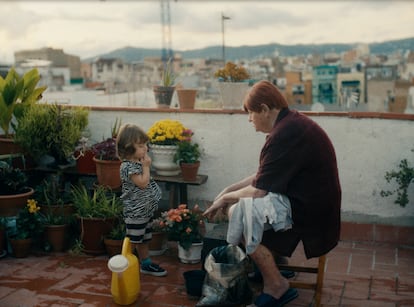
Gilda tells her origin story the same way every time, in both the film and during her performances on stage: She was supposed to be born with a twin sister, but her sibling came out first and was strangled by her mother’s umbilical cord, so Gilda carried on her sister’s legacy by invoking this lost second half. When director Enric Ribes first heard Gilda tell this story during one of her shows, he was fascinated and knew he had to meet her. “She’s like the storyteller of an almost forgotten generation,” he says. Together, they made a short, five-minute film in 2017, also called Cantando en las Azoteas. But Ribes felt that Gilda’s life merited a much longer and deeper project, so he proposed that they work together on a feature-length documentary, not strictly a biography, but something that, in a fictionalized way and with the help of a script, could reflect the reality of her daily life. The life she chose. And so, while Gilda no longer has a relationship with her biological family, in Ribes’ film we see how her neighbors, her community, have become her family.
“Everyone who appears [in the film] is someone she knows from her neighborhood in El Raval. Like the guy who collects scrap for a living, for example, they’ve known each other for years. I think he even spent a few weeks living in her apartment,” Ribes says. Despite the fact that her house in the film is not her real house – in real life, Gilda lost her home and now lives in a subsidized apartment complex – the film, Ribes says, is based on her authentic daily life: “Gilda lost everything. Most of her belongings are gone, save for a few outfits she was able to hold onto. When we were working on the short film, I scanned some of her personal photographs – if it weren’t for that, she wouldn’t even have any pictures of her mother. Most of the film’s story, in which Gilda spends a few days taking care of a six-year-old girl whose parents are going through some trouble, is also based on her real life: “I’ve always liked to make my own family, you know what I mean?” Gilda says. “The film is really well done. It’s very human, and it mirrors my real life. In my old house, there was a boy who lived upstairs and every time he’d climb the stairs with his parents, he’d call me to the door and I’d give him cookies and toys. I always had little details like that with my neighbors.”
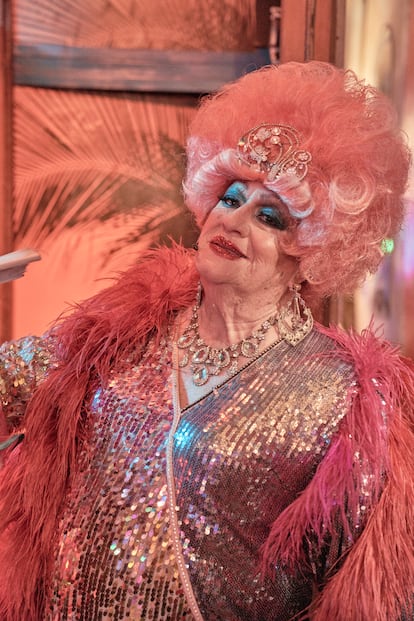
Back in the theater
The making of Cantando en las Azoteas benefited from the involvement of two of the most respected figures of contemporary Spanish cinema. The editing and advice of Isa Campo were essential, says director Enric Ribes, who co-authored the script with Xènia Puiggros. Campos was the scriptwriter for acclaimed Spanish drama Maixabel, and is highly regarded in the world of Spanish filmmaking for her expertise in fictionalized documentary formats, from her work with Isaki Lacuesta on films like Entre Dos Aguas. Another of the film’s key collaborators was Pilar Palomero, who won the 2021 Goya Awards for directing Las Niñas (Schoolgirls) and helped coach little Chloe Romero, the child actor who co-stars in Cantando en las Azoteas. Nevertheless, the dialogue in the film was not pre-written as a script. “We wanted the narration to be natural, and to not have to learn any lines,” Ribes says. “I would prompt Gilda, telling her: ‘do you remember when you told me about…?’ and she would just pick it up from there, because she’s a natural actor.” In fact, Gilda Love’s appearance in the film is not her first time on screen: in 2000, she appeared in the Dutch film Yo soy así, which charts the last days of Barcelona’s legendary nightclub, La Bodega Bohemia. In one of the scenes in Cantando en las azoteas, we see Gilda watching herself act in the old film, overcome with emotion.
Gilda reminds Enric Ribes of Catalan dancer Carmen Amaya: “She would sweat a lot when she danced, people said. She had a kidney problem, and because she stamped her feet and danced so hard, the sweat would flush out her system and that’s how she was able to live so much longer than anyone expected. Gilda has this same thing – about how the stage is killing her, but at the same time, the stage is what’s given her such a long life.” But Gilda says she gets her longevity from her family: her mother married at 14, and gave birth to a total of 20 children (seven brothers and nine sisters, along with four babies who didn’t survive). She lived to be 102 years old, and Gilda’s father lived to be 99. Gilda survived childhood and then decades under the Franco dictatorship. In El Raval, she found the freedom to be herself thanks to the local nightclubs, where she would often spend the night to avoid being arrested on the street under Franco’s Ley de Vagos y Maleantes – a law used to target vagrants, gay and trans people, sex workers, and anyone the regime deemed “antisocial.” “It’s true that people thought differently then. They would cut up my dresses with razors, but I’d just go out on stage and dance in the shreds. But yes, there was an atmosphere everywhere,” Gilda says.
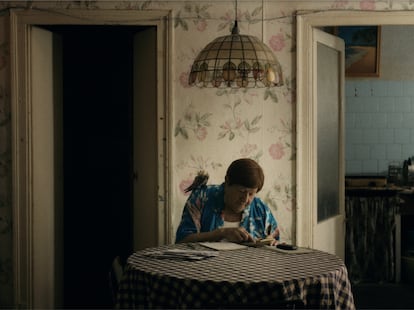
Gilda Love knows how popular drag shows have become now, thanks to figures like Ru Paul and the popular TV show Drag Race (a Spanish version of the show, Drag Race España, was launched last year). “These shows are on all the different platforms now, and Gilda has friends who download them for her,” Ribes says. “She says the contestants are very handsome, but they’re from a different generation. She doesn’t like that they don’t sing their own songs. That they lip sync.” Gilda confirms: “It’s not for me. My thing is drag de varieté – variety shows. Drag queens are a different style, I see them more as carnival than spectacle.” And this isn’t the only conflict Gilda has with the present. She’s sad to see the variety show scene disappear, and that there’s no longer anything even remotely resembling the glory days of the Kit Kat Club on Escudellers Street, or the Bodega Apolo where she worked for 17 years, or the long-lost Bodega Bohemia. “There used to be a lot of pianists in Barcelona. We sang songs in the streets, we would come up with the song in the streets, then go up to our room to rehearse. It was a very different life. I don’t know if there will ever be a wave of shows like that again. All there is now is porn. All anyone wants at their parties and weddings and dances and events is porn. That’s what the youth are into now, porn and jazz, with orchestras,” Gilda says over the phone as Ribes, listening on speaker, fails to contain his laughter. Nevertheless, Gilda still has gigs scheduled. This July 15th, for example, she’s performing at Raval Cuir, an event at the burlesque club El Molino de Barcelona.
“She lives in a world of shows,” Ribes says. “Yesterday, she told me she had to go get an outfit from a dressmaker way out at the end of the Metro line. She has this very quixotic sensibility, where she lives in a world of foreign places and old Hollywood classics, like Don Quixote with his books of chivalry.” Her name is an obvious reference to the film Gilda (1946), which she claims to have seen 13 times in the theater, and she boasts of once having met the film’s star, Rita Hayworth: “She came to Paris with that prince she married [Ali Khan] and I thought she was really nice. I approached her, told her I was a fan, and she replied in English, saying how much she loved that I was her fan. I liked her a lot, that slapping thing she did [a reference to the famous scene in Gilda where Hayworth slaps Glenn Ford] – that drove me crazy.”
Gilda’s memories of old Barcelona seem to be mediated by movies as well. As though she were talking about a musical in the style of On the Town or Les Demoiselles de Rochefort (The Young Ladies of Rochefort), Gilda remembers a city where “American ships were always arriving, there was a marvelous atmosphere along the Paralelo [the street once at the heart of Barcelona’s nightlife], people would sing from the roof terraces, and the terraces would be full.” Before, Gilda says, “I would perform in theaters, in variety shows. They would play a movie, and then afterwards I would come out on stage. None of that exists anymore. The theaters and venues are almost all closed down.” But now, at almost 100 years old, Gilda is back in theaters, playing the star of her own show in Cantando en las Azoteas.
Tu suscripción se está usando en otro dispositivo
¿Quieres añadir otro usuario a tu suscripción?
Si continúas leyendo en este dispositivo, no se podrá leer en el otro.
FlechaTu suscripción se está usando en otro dispositivo y solo puedes acceder a EL PAÍS desde un dispositivo a la vez.
Si quieres compartir tu cuenta, cambia tu suscripción a la modalidad Premium, así podrás añadir otro usuario. Cada uno accederá con su propia cuenta de email, lo que os permitirá personalizar vuestra experiencia en EL PAÍS.
¿Tienes una suscripción de empresa? Accede aquí para contratar más cuentas.
En el caso de no saber quién está usando tu cuenta, te recomendamos cambiar tu contraseña aquí.
Si decides continuar compartiendo tu cuenta, este mensaje se mostrará en tu dispositivo y en el de la otra persona que está usando tu cuenta de forma indefinida, afectando a tu experiencia de lectura. Puedes consultar aquí los términos y condiciones de la suscripción digital.
More information
Últimas noticias
Most viewed
- Sinaloa Cartel war is taking its toll on Los Chapitos
- Oona Chaplin: ‘I told James Cameron that I was living in a treehouse and starting a permaculture project with a friend’
- Reinhard Genzel, Nobel laureate in physics: ‘One-minute videos will never give you the truth’
- Why the price of coffee has skyrocketed: from Brazilian plantations to specialty coffee houses
- Silver prices are going crazy: This is what’s fueling the rally

